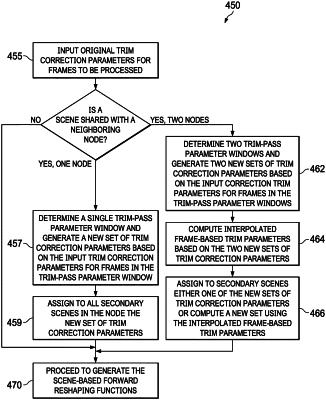| CPC H04N 19/85 (2014.11) [H04N 19/136 (2014.11); H04N 19/172 (2014.11); H04N 19/179 (2014.11)] | 14 Claims |

|
1. A method for trim-pass correction for a video segment to be encoded in a computing node, the method comprising:
receiving in a current computing node a first video sequence comprising video frames in a high dynamic range;
generating (455) for each video frame in the first video sequence a first forward reshaping function and frame-based trim-pass correction parameters, wherein a forward reshaping function maps frame-pixels from the high dynamic range to a second dynamic range lower than the high dynamic range;
for a subscene in the first video sequence that is part of a parent scene to be processed by the current computing node and one neighbor computing node:
determining (457) a trim-pass parameter window comprising frames in the first video sequence and bumper frames, wherein the bumper frames comprise video frames to be processed by the neighbor computing node;
computing (459) scene-based trim-pass correction parameters based on the frame-based trim-pass correction parameters of the frames in the trim-pass parameter window;
generating a scene-based forward reshaping function based on the first forward reshaping functions of the frames in the subscene; and
generating for the subscene an output forward reshaping function based on the scene-based trim-pass correction parameters and the scene-based forward reshaping function, and
if the neighbor computing node is prior to the current computing node, then the trim-pass parameter window comprises all (B) bumper frames before the first frame of the first video sequence (C0), up to, but not including, frame Cs=C0+B; and
if the neighbor computing node is subsequent to the current computing node, then the trim-pass parameter window comprises frame Cs=CL−1−B and all subsequent frames, including all bumper frames after the last frame of the first video sequence, wherein L denotes the number of frames in the video segment.
|